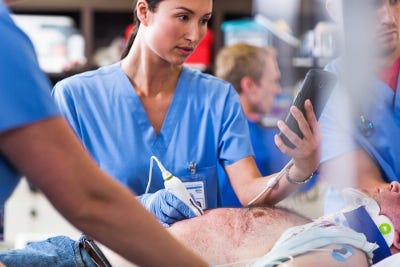How Philips Made App-based Ultrasound a Reality
July 28, 2015
Previous innovations, and collaboration with FDA, helped Philips when it came to creating ultrasound that simply plugs into a smart device, says a Philips vice president who helped lead the project.
|
Randy Hamlin |
Chris Newmarker
Royal Philips in September will start selling an FDA-cleared ultrasound transducer called Lumify that simply plugs into a tablet computer via its USB port. The interface runs off an app on the tablet.
Call it the birth of app-based ultrasound.
Qmed recently interviewed Randy Hamlin, vice president and business segment leader of Philips Ultra Mobile, to find out more about Lumify, and the design and regulatory challenges overcome to make it a reality:
Qmed: Which technological advances made app-based ultrasound possible?
Hamlin: While I was [vice president of R&D at Philips Healthcare], we were looking at feasibility projects that were interesting, but didn't know whether they were technically possible. About 12-plus years ago, we created this technology where you put more of the electronics in a transducer. We were doing that because we were creating the world's first real-time 3-D ultrasound imaging transducer. In order for us to do that, we had to take more of the electronics that were in an ultrasound cart, and place them in the transducer so that you could use up-front processing. There was so much information being generated by thousands of little elements that were transmitting sound and receiving sound that we would have to have a huge cable that would go to this large processor. We had to invent what we called a funnel technique, funneling all this information to a more reasonable mount. It requires us to have this processor in the transducer.
You go back about five years ago from today, there was a group of engineers in my office, and we were asking: "Why don't we take this approach into the 2-D world?" There were some feasibility projects we started to adapt to that same concept. That was the birth of app-based ultrasound. It's really centered around the ability to put all the electronics in the transducer itself, in the device that couples to the patient. That frees you up to then have a CPU and display device at the other end of the wire. For us to achieve that, we needed highly capable electronics in a low-power format, so we just use the power from the smart devices. That is fundamentally a breakthrough.
If you look at taking any off-the-shelf smart devices, it's really about being able to leverage miniaturization and low-powered electronics to then power your device from smart devices. That was really the breakthrough that allowed us to take app-based ultrasound to the next level. That's how the birth of it happen.
|
This marketing image from Philips shows the Lumify in action. (Image courtesy of Royal Philips) |
Qmed: Why is app-based ultrasound so beneficial?
Hamlin: Your world opens up. You have all this amazing flexibility. That's where we see app-based ultrasound being so exciting for us. It fits on this very smart platform of smart devices. It allows us to constantly update content to our users in a very simple way. It's like accepting your app updates that you have on your smart device today. It eliminates the complexity and overhead of our customers have to wait a long time for software upgrades. There are some really amazing things that open up as a tool solution when you go to an app-based iteration.
Ultrasound that you can carry with you has been in the market a couple years now. What they struggle with is the image performance. The clinician really needs critical information at the bedside. We were able to overcome that through the Philips innovation migrating from real-time 3-D ultrasound to the 2-D world. We were able to deliver high image quality in an affordable solution. ... It sits on the user's own smart device. They're highly connective, ... solutions that are connected [to the electronic medical record] ... in a very seamless way. They can put their own security services on that device to protect their own device. The whole security thing is being taken care of as well. ... It's a bring-your-own-device solution. ... We fit into the existing paradigm of tools they already have today.
Qmed: Lumify is presently compatible with the Android Nexus 7-inch tablet, but the goal is to have it compatible with most Android and Apple devices in the future?
Hamlin: Our intent in the future is to be ubiquitous to the operating systems. ... Our first app is an imaging app that does a lot of ultrasound things. Over time, we'll be adding additional capabilities, a lot of other applications that are simply downloaded by our customers, other transducer types, other tablet devices with other operating systems. We'll be delivering that through a Web portal that is part of our solution.
It's the innovation of the transducer coupled with the user's smart device. And then that's coupled to our Web portal that enables them to access training materials, the latest app information. They can manage their devices through our cloud app dashboard that we have. And so if an institution has about 10 or 12 of these, they know where they're at in terms of who is using them and how much they are being used. ... In the future, many institutions will have to track utilization and how many criticals they're doing, because they'll have to do accreditation.
Qmed: Why are you offering Lumify under a subscription model?
Hamlin: Many customers are interested in doing more ultrasound, but ... they don't want to go through the process of acquiring a $30,000 ultrasound. ... With our subscription model, there's no upfront fee to start, and there's no penalty for exiting at any time. We're doing this because, No. 1, it really breaks down another barrier of adoption, which is large capital expenditure. It gives our users flexibility where if the demand of patient care increases, they can add subscriptions very quickly. If they demand drops, they can drop some subscriptions. ... It really matches access of ultrasound to the demand of healthcare.
Qmed: How much is the subscription going to cost?
Hamlin: I can't share pricing yet, because we're still finalizing pricing. But we'll have it available in September when we're rolling the product out. Our incentive is to make it very reasonable for our clinicians. We want to have them say, "Wow, I can use ultrasound. There's not a barrier for me." Our goal is to make it a really attractive subscription.
Qmed: Where do you think this will initially be used?
Hamlin: The first market we'll be going into will be the critical care market within hospitals. They want something readily available to them at bedside or on the floor of hospital or in the ICU. Also, the emergency department can have easier access to ultrasound for trauma patients as they come in. Outside of the hospitals, there are sports medicine clinics. ... And over time, we see them going into urgent care centers ... long-term care centers.
Qmed: Tell us more about the open apps platform and the Philips' Ultrasound Consortium?
Hamlin: Our intent is to work with the consortium members and non-consortium members to help us develop app ideas. ... We find it's valuable to share ideas. ... What we're offering this fall is what I call the beginning of a development platform. It's a very open platform. Our intent is to one day offer a development kit, and they can develop their own apps. That's why I'm excited about it. It's just the beginning. ... We really see the future users being contributors for future applications.
Qmed: What level of FDA regulation does the Lumify have?
Hamlin: It's a Class II ultrasound device. We already have a 510(k) for our first transducer. And we're working on other transducers that will need 510(k) clearance. ... This can only be used by physicians and qualified purchasers of medical devices, so this is not available to the consumer to purchase.
Qmed: How did you navigate regulatory hurdles related to potentially plugging into so many different smart device platforms?
Hamlin: We're breaking a lot of new ground with Lumify, so we've been collaborating a lot with the FDA. ... We have minimum specified requirements of the smart device displaying ultrasound. The FDA has agreed to that minimum specification. They're very comfortable saying that anything that exceeds that minimum specification is underneath the 510(k). We have established where the bar is based on resolution and power of the smart device. And on apps that are developed, Philips takes responsibility that any app offered on our platform has 510(k). A 510(k) is required. ... We're the gatekeepers of that. ...
We have found Android devices that do not function consistently with others. So our website will include a qualified list of smart devices that we guarantee are compatible. And then we will have our minimum specification that will say these other devices [that surpass it] may work, but we will not guarantee them.
Qmed: Anything else that would be good to add about Lumify?
Hamline: I'm excited about how this could change healthcare so much. We're trying to change healthcare and keep people out of hospitals.
Refresh your medical device industry knowledge at MEDevice San Diego, September 1-2, 2015. |
Chris Newmarker is senior editor of Qmed and MPMN. Follow him on Twitter at @newmarker.
Like what you're reading? Subscribe to our daily e-newsletter.
About the Author(s)
You May Also Like




